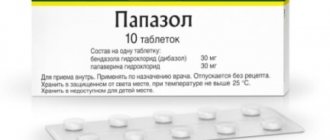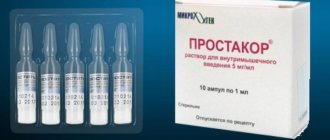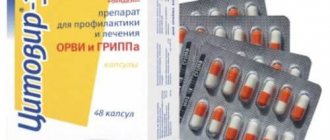Composition of the drug Fthalazol
Composition of the drug Fthalazol
The main active ingredient of Phthalazole is Phthalylsulfathiazole, which has a pronounced antimicrobial effect. After entering the stomach, the substance is practically not absorbed. In the small intestine, phthalylsulfathiazole breaks down, forming sulfathiazole, which does not have time to be adsorbed, thereby providing an antimicrobial effect against intestinal infections. Active against both gram-positive and gram-negative microorganisms.
Phthalylsulfathiazole is excreted mainly in feces, and a small amount (about 10%) is excreted in urine.
In addition to the main active ingredient, Phthalazol contains the following ingredients:
- potato starch (used as a tablet filler);
- calcium stearate (food emulsifier E572, acts as a forming agent and thickener for tablet mass);
- low-molecular-weight medical polyvinylpyrrolidone (has a detoxification effect. It is used in the treatment of toxic forms of acute infectious gastrointestinal diseases, such as salmonellosis, dysentery, as well as foodborne toxic infections, exacerbation of chronic enterocolitis, liver failure);
- aerosil (silicon dioxide, in the preparation acts as a carrier of active substances, as well as an agent that prevents caking of the tablet mass).
Phthalazol: analogues
- Oriprim;
- Bactrim;
- Biseptol;
- Sinersul;
- Urbazon;
- Metosulfabol;
- Oriprim;
- Salosinal;
- Renitol;
- Prednisolone;
- Pentasa;
- Dvaseptol;
- Co-trimoxazole;
- Fortecortin.
Phthalazol: price. As for the price of this drug, it is quite affordable and anyone can afford it. The average price of the drug is 30-40 rubles.
There are a huge number of analogues of the drug on the pharmaceutical market. These are medicines that contain phthalylsulfathiazole (sulfathiazole, a component that inhibits the synthesis of folic acid in the microbial cell). Since the drug was produced back in the days of the USSR, when there were no commercial names of drugs, all synonyms of the drug have the same name - Fthalazol (-Darnitsa, -Ros, -Rusfar and others). Analogs are drugs with a similar or the same spectrum of action, but with a different active ingredient.
If it is necessary to replace Fthalazol with another drug, you can select a drug from the presented catalog of analogues:
- Bactrim;
- Biseptol;
- Dvaseptol;
- Co-trimoxazole;
- Oriprim;
- Metosulfabol;
- Sinersul;
- Sulotrim;
- Phtazin;
- Furazolidone.
Pharmacological action of Phthalazole
Phthalazole is a sulfonamide drug that has a bacteriostatic effect. The drug is slowly absorbed from the gastrointestinal tract, thus the main amount of Phthalazole is retained in the intestines, where the active part of the sulfonamide is gradually eliminated.
Pharmacological action of Phthalazole
The drug blocks the reproduction and spread of the following bacteria:
- streptococcus;
- staphylococcus;
- pneumococcus;
- meningococcus;
- gonococcus;
- Escherichia;
- shigella;
- Proteus and others.
Phthalazole is also effective against large viruses such as chlamydia trachoma, as well as the virus that causes follicular conjunctivitis.
Indications for use of Phthalazol
Instructions for use Fthalazol advises using the drug for diseases such as:
— acute dysentery (shigillosis) is an infectious disease characterized by a syndrome of general intoxication with damage to the gastrointestinal tract, mainly the distal colon. The disease is caused by Shigella bacteria, which are able to grow in ordinary nutrient media. Symptoms of intoxication are caused by endotoxin, which is released when microbial cells are destroyed. Shigella produces, in addition to endotoxins, several types of exotoxins: cytotoxins, which damage cell membranes, enterotoxins, which provoke increased secretion of salts and fluids in the intestinal lumen, and neurotoxins. Phthalazol successfully copes with Shigella;
Indications for use of Phthalazol
- chronic dysentery in the acute stage, which occurs due to improper treatment of the initial acute dysentery;
- colitis - inflammatory diseases of the mucous membranes of the large intestine. Chronic colitis affects people who have problems with the digestive system. Acute colitis, as a rule, is of dysenteric origin, but the cause may be pathogenic bacteria such as staphylococci, streptococci, E. coli and foodborne illnesses;
- enterocolitis - simultaneous inflammation of the large and small intestines. They can be infectious and non-infectious. Infectious colitis, depending on the cause of the disease, is divided into bacterial and parasitic. The cause of bacterial enterocolitis is the effect on the intestines of dysentery bacillus, Shigella, and Salmonella. Parasitic enterocolitis develops as a result of colonization of the intestine by helminths, Trichomonas and amoebas;
— gastroenterocolitis is an inflammatory disease of simultaneously such organs as the stomach, large and small intestines. The causative agents of the disease are salmonella, yersinia, staphylococcus, E. coli, and rotavirus. Gastroenteritis most often affects entire families or groups where poor quality food was consumed together;
— amoebic dysentery is an acute inflammatory disease of the sigmoid, rectum, cecum and ascending colon due to infection of the body with the dysenteric amoeba Entamoeba Histolytica. Amoeba is insidious in that it provokes tissue melting, necrosis of the mucous membrane with the formation of ulcers and abscesses. It can affect the deep layers of the intestinal walls, and from there spread to the lungs, liver, and brain, causing abscesses in these organs;
- paratyphoid infections. The use of Fthalazol is not enough for these diseases, so the drug is used as a concomitant drug in complex therapy;
— operations on the intestines (Fthalazol is used as a prophylactic agent in case of purulent complications).
Contraindications and side effects
Acute dysentery (shigellosis), chronic dysentery in the acute phase, colitis, enterocolitis, gastroenteritis, prevention of infectious complications during intestinal operations.
Hypersensitivity to phthalylsulfathiazole, sulfonamide drugs and/or other components of the drug.
Graves' disease, blood diseases, acute hepatitis.
If you follow the instructions, the tablets are recommended for use for various intestinal disorders that arise as a result of exposure to the quantitative composition and volume of food consumed. An additional feature of the medicine is that it significantly reduces the increased level of gas formation.
- dysentery;
- colitis, gastroenteritis and enterocolitis;
- diarrhea of various origins;
- in addition, it is worth noting that the use of this drug is recommended for the prevention of suppuration in the intestinal cavity after operations.
The use of phthalazole is indicated for patients without infectious lesions of the mucous membranes of the gastrointestinal tract if they are being prepared for surgical interventions. Phthalazole is prescribed to children in advanced stages of dysbacteriosis, provoked as a result of taking broad-spectrum antibiotics. In this case, the tablets suppress the symptoms of dysbacteriosis and the manifestations of diarrhea.
Phthalazol's indications for use include a fairly large list of diseases that it successfully treats. But there is an equally impressive list of contraindications that you must definitely pay attention to in order to avoid negative consequences instead of the expected benefits.
Phthalazole taken for diarrhea can cause the following side effects:
- Headaches and dizziness, these include: Intolerance to any drugs from the sulfonamide group if the use of Phthalazole is primary;
- increased sensitivity of the body or allergic reactions to any component of the drug;
- diseases of the hematopoietic system (including banal iron deficiency anemia);
- endocrine pathologies, in particular diseases of the thyroid gland (diffuse toxic goiter primarily);
- chronic kidney pathologies;
- acute liver pathologies;
- intestinal obstruction.
The instructions for Fthalazole also indicate side effects. They often develop in the event of an incorrectly selected dosage, unaccounted for contraindications, or the presence of other chronic pathologies that affect the body’s reactivity.
It is also necessary to take into account compatibility with other drugs that may be prescribed in complex therapy or taken by the patient for existing chronic pathologies of other organs and systems.
- With long-term use - apathy and depression;
- cyanosis of the skin, in rare cases – inflammation of the heart muscle (myocarditis);
- changes in blood formula, destruction of red blood cells, anemia;
- stomatitis and fungal infections of the oral cavity;
- nausea, vomiting and increased diarrhea - with prolonged or inadequate therapy;
- allergic reactions are predominantly of a skin nature, possible lacrimation, runny nose, slight sore throat.
If any of these manifestations are detected, you should immediately consult a doctor to prescribe a search for a safer drug, and, if necessary, carry out symptomatic treatment of side effects.
Indications for use of the drug
are: dysentery (intestinal disease caused by protozoa), colitis (inflammation of the colon), gastroenteritis (inflammation of the mucous membranes of the stomach and small intestine), intestinal surgery.
Contraindicated in case of hypersensitivity to the constituent components of the drug, Graves' disease, acute hepatitis, blood disease, children under 2 years of age.
Phthalazole, like all medical drugs, has contraindications. It may adversely affect or worsen the treatment of another disease that the patient already has.
The reason for not prescribing Phthalazole to a patient is:
- individual intolerance to the ingredients of the drug;
- allergic reaction to sulfonamides;
- renal chronic diseases;
- acute liver disease;
- glomerular nephritis;
- Graves' disease;
- acute functional liver damage;
- diseases accompanied by a violation of the structure of blood cells;
- paralytic intestinal obstruction.
It is not recommended for use by young children under three years of age, as well as by pregnant women and during breastfeeding.
When using the drug, it is necessary to observe the exact dosage, since exceeding the prescribed dose of the drug can lead to negative reactions from various body systems. If the patient has an individual intolerance to sulfonamides, continuing to take the drug is prohibited. Treatment with the drug for acute hepatitis or other blood diseases is also not recommended. Intestinal obstruction, Graves' disease and renal failure are sufficient grounds for discontinuing the medication.
Dosage of Phthalazol and method of its use
Dosage of Phthalazol and method of its use
Phthalazole is used orally 4 to 6 times a day, half an hour before meals. In the case of acute dysentery in adults, the drug is prescribed as follows:
- Days 1-2 – 1 g every 4 hours, the daily norm is 6 g;
- Days 3-4 – 1 g every 6 hours, daily norm – 4 g;
- Days 5-6 – 1 g every 8 hours, daily norm – 3 g.
This is the first course of treatment and its total dose is 25-30 g.
After 5-6 days, a second course of treatment is carried out according to the following scheme:
- Days 1-2 – 1 g every 4 hours, and at night the interval is 8 hours, the daily norm is 5 g;
- Days 3-4 – 1 g every 4 hours, only in the daytime, daily norm – 3 g.
The total dose of the second course is 21 g. In case of mild disease, the dose can be reduced to 18 g.
The maximum dose for adults is 2 g as a single dose and 7 g as a daily dose.
A single dose of Phthalazol for children aged 3 to 7 years is 0.4 - 0.5 g, and for children aged 8 to 14 years - 0.5 - 0.75 g. The course of treatment in children should not exceed 7 days.
In the case of other diseases, Fthalazol is prescribed 1-2 g every 4-6 hours for the first 2-3 days.
Children are prescribed the drug on the 1st day, 0.1 g per 1 kg of body weight per day. The drug is used in equal doses every 4 hours with a break at night. And in the following days, use 0.2 - 0.5 g every 6-8 hours.
The prescription and dose adjustment according to the severity of the disease is determined by the attending physician.
Phthalazole for diarrhea: 8 benefits and dosage
Few people are immune from infectious intestinal diseases. Modern medicine offers a lot of pharmacological drugs that can solve this problem. Fthalazol anti-diarrhea tablets are especially effective.
This sulfonamide antimicrobial drug, developed by Soviet scientists, has been actively used for more than half a century. Over the entire period, its effectiveness and safety, as well as its effect on the human body, have been carefully studied.
The effectiveness of Phthalazole against diarrhea
Phthalazole actively affects pathogenic microbes in the intestines and eliminates signs of the disorder. The effectiveness of the product is determined by its composition, where the main active ingredient is phthalylsulfathiazole.
The drug has many positive reviews due to its pharmacological advantages:
- Doesn't cause habit.
- Performs antibacterial actions.
- Active components are not absorbed into the blood.
- It is harmless, so children from three years old can take it.
- Long term of use.
- Does not accumulate in the body.
- Availability, as it can be purchased in any area.
- Low price.
In addition, Fthalazol eliminates food poisoning, intestinal infections and other inflammatory processes. It actively destroys various pathogenic bacteria that cause diarrhea:
- staphylococci;
- gonococci;
- pneumococci;
- intestinal, pseudomonas, dysentery bacillus;
- Proteus bacteria.
Fthalazol is mainly prescribed for diarrhea. But it copes well with dysentery, gastroenterocolitis, Salmanella paratyphoid infection, and ulcerative necrotizing colitis.
When taking the medication, bacteria stop multiplying and die.
Regimen and dosage
If you have health problems, you need to know when and how to take Fthalazol for diarrhea. The drug is administered orally in the doses prescribed in the instructions. The portion dosage depends on the age, weight and individual characteristics of the patient.
For adults
To be treated with Phthalazol, you do not need to have a medical education or resort to the services of a qualified healthcare professional. Before taking, you need to refrain from eating food for half an hour. Without chewing the tablet, you should swallow it and drink at least one glass of water.
The form of Phthalazol is convenient in that it allows you to use it without disturbing your daily household activities.
The advantages include:
- portability;
- ease of storage and transportation;
- accuracy of the therapeutic portion.
For diarrhea in an adult, it is recommended to take Fthalazol in two courses. The first course is prescribed for the treatment of intestinal disease. The second strengthening course is carried out seven days after the first.
1st year 2nd year
| 1 day – 2 pcs. for 6 doses per day; | 1 day – 2 pcs. for 5 doses per day; |
| Day 2 – 2 pcs. every 4 hours (same as on the first day); | Day 2 – repeat the first day; |
| Day 3 – 2 pcs. for 4 doses per day; | Day 3 – 2 pcs. for 4 doses per day, no need to take at night; |
| Day 4 – repeat day 3; | Day 4 – repeat day 3; |
| Day 5 – 2 pieces in 3 doses per day; | Day 5 – the same as in the first course; |
| Day 6 – repeat day 5. | Day 6 – repeat the fifth day, if the condition has stabilized, you can cancel this day. |
An important point in the treatment of Phthalazol for diarrhea and other intestinal infections in adults is to take it at regular intervals. Therapy should not be interrupted, since the active ingredients of the drug must constantly fight intestinal microorganisms. To do this, during treatment they must be in the body in the appropriate concentration.
For children
The chemical composition of Phthalazole is so safe that it can be used to treat small children. The drug does not belong to a risk group, therefore it is absolutely harmless. In order not to cause any side effects in your baby, you need to familiarize yourself with how to take Fthalazol for diarrhea.
The medication has been an effective method against childhood diarrhea for many years. Treatment must be approached individually, taking into account the child’s weight, age and causes of the disease.
Ages up to three years 3–7 years 7–12 years 12 and older
| Half 6 times a day every 4 hours. | Half a 500 mg pill 6 times a day. | Take 500–700 mg 4 times a day. | Take 1-1.5 pieces in 1-1.5 g 6 times in the first two days, and then 4 times in the next two days is enough. Then go to three times a day. |
Despite the safe composition of the drug, before you start treating children's diarrhea with it, you should consult a pediatrician.
If it is difficult for your baby to swallow the pill as a whole, you can crush it or break it into small pieces. Fthalazol should be given 30 minutes before meals and washed down with plenty of warm water.
Treatment is carried out until symptoms disappear completely, but not less than 6–7 days.
Is it possible during pregnancy?
During pregnancy, women should take as little medication as possible. It's better to try to do without them. In case of intestinal disorders, Fthalazol can be taken by expectant mothers only as prescribed by the attending physician.
Studies have shown that antimicrobial components can cross the placenta. And this negatively affects the fetus.
Also, Fthalazol is not recommended to be taken during the lactation period. The main component phthalylsulfathiazole, when released into breast milk, can provoke the development of kernicterus with a high amount of bilirubin in the blood of a newborn. This is a severe brain injury that can lead to mental retardation by the age of three.
Doctors do not recommend that pregnant women and during breastfeeding take Fthalazol and any other medications on their own without a prescription from a specialist.
Contraindications
Phthalazole, like all medical drugs, has contraindications. It may adversely affect or worsen the treatment of another disease that the patient already has.
The reason for not prescribing Phthalazole to a patient is:
- individual intolerance to the ingredients of the drug;
- allergic reaction to sulfonamides;
- renal chronic diseases;
- acute liver disease;
- glomerular nephritis;
- Graves' disease;
- acute functional liver damage;
- diseases accompanied by a violation of the structure of blood cells;
- paralytic intestinal obstruction.
It is not recommended for use by young children under three years of age, as well as by pregnant women and during breastfeeding.
Side effects
The sulfanilamide antimicrobial substance is easily tolerated by patients, since it has low adsorption. Systemic side effects are rare because only a small part of the active substance is absorbed into the body.
Adverse reactions affect different organ systems:
- nervous;
- respiratory;
- cardiovascular;
- circulatory;
- Gastrointestinal tract;
- urinary.
In accordance with this, the patient may exhibit a number of negative symptoms:
- dizziness, headaches;
- damage to the heart muscle, myocardium;
- skin cyanosis;
- diseases of the hematopoietic system;
- vomit;
- nausea;
- eosinophilic Loeffler's pneumonia;
- skin rash, itching.
When taking the medication, you must follow the exact dosage, since exceeding the norm of the therapeutic portion also leads to side effects.
The pharmaceutical market offers a wide range of anti-diarrhea drugs. Phthalazol has been and remains effective and popular due to its properties and pricing policy.
It can be purchased both at the pharmacy and through online stores. Despite its easy availability and harmlessness, self-medication is still not worth it.
Before using any medical drug, you should consult a doctor to avoid negative consequences.
Interaction of Phthalazole with other drugs
Phthalazole is not compatible with drugs such as:
- anti-tuberculosis drug PAS;
- Difenin. The drug increases the toxicity of Phthalazole;
- Oxacillin. Phthalazole reduces the activity of Oxacillin;
- Nitrofurans. The risk of developing methemoglobinemia and anemia increases;
- Vitamin K and calcium chloride. Blood clotting decreases;
- Preparations of male and female sex hormones. Phthalazole has a depressing effect on the function of sex hormones.
special instructions
The use of Fthalazol during pregnancy and lactation is allowed only in exceptional cases: when the benefit to the mother outweighs the risk to the child. The fact is that Fthalazol quite easily penetrates the placenta and is found in significant concentrations in the blood of the fetus. And in mother’s milk, the concentration of the drug reaches the concentration of Phthalazole in the blood serum. In this case, the baby receives an amount of the drug through milk that can negatively affect his health.
An overdose of the drug entails such negative effects as headache, nausea and vomiting, damage to the oral cavity, gastritis, hepatitis, and blockage of urination. In such cases, stop using the drug and wash the stomach with a solution of sodium bicarbonate and prescribe plenty of fluids.
During the period of taking Fthalazol, the use of B vitamins (thiamine, riboflavin, nicotinic acid) is recommended, since in the process of inhibiting the growth of E. coli, the synthesis of these vitamins is reduced.
♦ Category: Medicines.
Side effects
Most often, the drug Fthalazol is well tolerated by most patients. In rare clinical cases, side effects such as:
- formation of kidney stones;
- gastritis;
- headache;
- nausea;
- allergic reactions on the skin;
- stomatitis;
- anemia (exclusively in case of prolonged use);
- pain syndrome in the epigastric region.











